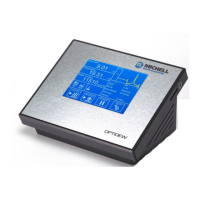Optidew User’s Manual
34 97551 Issue 1, February 2018
OPERATION
almost indefinitely. However, as the temperature rises, so does the likelihood of
desorption occurring.
In practical terms, as the temperature of the environment fluctuates, water molecules
are adsorbed and desorbed from the internal surfaces of the sample tubing, causing
small fluctuations in the measured dew point.
Sample Tubing Length
The sample point should always be as close to the critical measurement point as possible,
in order to obtain a truly representative measurement. The length of the sample line
to the sensor or instrument should be as short as possible. Interconnection points and
valves trap moisture, so using the simplest sampling arrangement possible will reduce
the time it takes for the sample system to dry out when purged with dry gas.
Over a long tubing run, water will inevitably migrate into any line, and the effects of
adsorption and desorption will become more apparent. It is clear from the graph shown
above that the best materials to resist transpiration are stainless steel and PTFE.
Trapped Moisture
Dead volumes (areas which are not in a direct flow path) in sample lines, hold onto
water molecules which are slowly released into the passing gas; this results in increased
purge and response times, and wetter than expected readings. Hygroscopic materials
in filters, valves (e.g. rubber from pressure regulators) or any other parts of the system
can also trap moisture.
Sample Conditioning
Sample conditioning is often necessary to avoid exposure of sensitive measuring
components to liquids and other contaminants which may cause damage or affect the
accuracy over time, depending on the measurement technology.
Particulate filters are used for removing dirt, rust, scale and any other solids that may
be in a sample stream. For protection against liquids, a coalescing filter should be used.
The membrane filter is a more expensive but highly effective alternative to a coalescing
filter. It provides protection from liquid droplets, and can even stop flow to the analyzer
completely when a large slug of liquid is encountered.
Condensation and Leaks
Dewpoint > T Dewpoint < T
Figure 28
Formation of condensation

